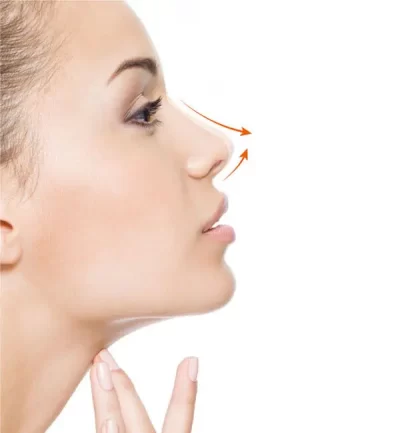Rhinoplasty is not only about reshaping the nose, but also about achieving overall balance and harmony in the face. Rhinoplasty in women requires finer details and aesthetic proportions than in men. In the ideal nose design, the nose should not overshadow other features of the face, but rather emphasise the natural beauty of the face.
Basic Criteria for Rhinoplasty in Women
One of the most important points in female nose aesthetics is the position of the bridge of the nose and the tip of the nose. The bridge of the nose can be straight or slightly curved. In addition, the tip of the nose can be positioned approximately 1-2 mm higher than the bridge of the nose. These small but important details give the nose an elegant and feminine appearance.
The angle between the nose and upper lip is also decisive for an aesthetic facial ratio. In women, the ideal nose-lip angle should generally be around 110%. This ratio makes the face appear more attractive and balanced.
The shape of the nostrils is another critical factor. When viewed from the side profile, the nostrils should be symmetrical and elliptical in shape. When viewed from the front profile, the nostrils should be slightly visible and offer a natural aesthetic, like a bird with its wings spread.

The Golden Ratio and Facial Symmetry
For a successful nose aesthetic, not only the shape of the nose but the entire face must be taken into consideration. The golden ratio is the basis of aesthetic design, and the nose must be shaped in accordance with these ratios.
When evaluating factors such as the length, width, protrusion, or tip structure of the nose, its harmony with the cheekbones, jaw structure, eyebrows, and forehead must be taken into consideration. If this harmony is not achieved, even if the nose looks aesthetically pleasing on its own, it will not blend in with the face and will not look natural.
The Importance of a Dynamic Appearance in Rhinoplasty
Nose aesthetics should not be evaluated solely as a static structure. The shape of the nose when speaking, smiling or making facial expressions in daily life should also be taken into consideration. Nose design should be planned by examining it from different angles, not just from the front or profile.
In particular, the tip of the nose drooping when smiling or a noticeable break in the bridge of the nose can have a negative effect on the aesthetic result. For this reason, a detailed analysis should be carried out before the operation, and the nose design should be examined from all angles and planned individually for each person.
The Role of Technology in Aesthetic Surgery: 3D and Hologram Simulations
Today, 3D imaging and hologram technologies provide a great advantage to patients in rhinoplasty planning. Thanks to these systems, patients can realistically see how they will look after rhinoplasty. Especially hologram technology helps patients to determine the ideal design together with their surgeons by examining their noses from different angles.
These technologies increase patient satisfaction while also enabling more informed decisions. Creating a nose design that best suits the individual’s facial structure and expectations also makes the post-operative process smoother.
Conclusion
Nose aesthetics in women should be designed to complement the overall symmetry and natural beauty of the face. The nose should be in harmony with the other features of the face and should not stand out excessively at first glance. Thanks to modern aesthetic surgery techniques and technological capabilities, nose aesthetics today offers much more personalised and successful results.
The most important point to remember: Successful nose aesthetics depends on achieving a delicate balance in the details.









